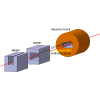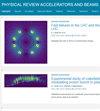欧洲核子研究中心超级质子同步加速器新一代内部束流倾卸装置的设计和早期运行
IF 1.5
3区 物理与天体物理
Q3 PHYSICS, NUCLEAR
Physical Review Accelerators and Beams
Pub Date : 2024-04-12
DOI:10.1103/physrevaccelbeams.27.043001
引用次数: 0
摘要
超级质子同步加速器(SPS)是欧洲核子研究中心(CERN)大型强子对撞机喷射器链的最后一级,它还为几个固定靶实验提供质子和离子束。SPS 自 1976 年开始运行,多年来一直在不断升级。为了使 SPS 安全运行,其内部的束流倾卸装置必须能够反复吸收循环束流的能量,而不会受到影响其功能的损坏。SPS 的最新升级要求其束流倾卸装置能够吸收动量谱从 14 GeV/c 到 450 GeV/c 的质子束,平均束流功率高达 ∼ 270 kW。本文介绍了在大型强子对撞机喷射器升级项目框架内,欧洲核子研究中心加速器综合体于2019-2020年停运期间在SPS的一个长直段上安装的新型SPS束流倾卸装置的技术细节。这种新的束流倾卸装置自 2021 年 5 月起开始运行,预计使用寿命为 20 年。束流储存器设计的主要挑战在于需要耗散大量热能,以避免过热和损坏束流储存器本身,同时还要承受高水平的诱导辐射,这对监测束流储存器和修复运行期间出现的任何问题的人员访问造成了影响。因此,在设计过程中,对光束倾泻核心及其冷却系统在正常运行和光束倾泻最坏情况下的反应进行了大量的热力学有限元模拟。为确保束流倾弃堆芯及其水冷系统之间的高导热性,在制造过程中采用了热等静压技术。在光束倾弃装置中安装了一整套仪器,以便在运行期间对其进行监测,并根据运行反馈对数值模型进行交叉检验。此外,还对光束倾弃场及其基础设施设计进行了优化,以确保在最大限度地降低人员所受辐射剂量的同时,还能对其进行维护、修理或更换。本文章由计算机程序翻译,如有差异,请以英文原文为准。

Design and early operation of a new-generation internal beam dump for CERN’s Super Proton Synchrotron
The Super Proton Synchrotron (SPS) is the last stage in the injector chain for CERN’s Large Hadron Collider, and it also provides proton and ion beams for several fixed-target experiments. The SPS has been in operation since 1976, and it has been upgraded over the years. For the SPS to operate safely, its internal beam dump must be able to repeatedly absorb the energy of the circulating beams without sustaining damage that would affect its function. The latest upgrades of the SPS led to the requirement for its beam dump to absorb proton beams with a momentum spectrum from 14 to and an average beam power of up to . This paper presents the technical details of a new design of the SPS beam dump that was installed in one of the long straight sections of the SPS during the 2019–2020 shutdown of CERN’s accelerator complex within the framework of the Large Hadron Collider Injectors Upgrade Project. This new beam dump has been in the operation since May 2021, and it is foreseen that it will operate with a lifetime of 20 years. The key challenges in the design of the beam dump were linked to the high levels of thermal energy to be dissipated—to avoid overheating and damage to the beam dump itself—and high induced levels of radiation, which have implications for personnel access to monitor the beam dump and repair any problems occurring during operation. The design process, therefore, included extensive thermomechanical finite-element simulations of the beam-dump core and its cooling system’s response to normal operation and worst-case scenarios for beam dumping. To ensure high thermal conductivity between the beam-dump core and its water-cooling system, hot isostatic pressing techniques were used in its manufacturing process. A comprehensive set of instrumentation was installed in the beam dump to monitor it during operation and to cross-check the numerical models with operational feedback. The beam dump and its infrastructure design were also optimized to ensure it can be maintained, repaired, or replaced while minimizing the radiation doses received by personnel.
求助全文
通过发布文献求助,成功后即可免费获取论文全文。
去求助
来源期刊

Physical Review Accelerators and Beams
Physics and Astronomy-Surfaces and Interfaces
CiteScore
3.90
自引率
23.50%
发文量
158
审稿时长
23 weeks
期刊介绍:
Physical Review Special Topics - Accelerators and Beams (PRST-AB) is a peer-reviewed, purely electronic journal, distributed without charge to readers and funded by sponsors from national and international laboratories and other partners. The articles are published by the American Physical Society under the terms of the Creative Commons Attribution 3.0 License.
It covers the full range of accelerator science and technology; subsystem and component technologies; beam dynamics; accelerator applications; and design, operation, and improvement of accelerators used in science and industry. This includes accelerators for high-energy and nuclear physics, synchrotron-radiation production, spallation neutron sources, medical therapy, and intense-beam applications.
 求助内容:
求助内容: 应助结果提醒方式:
应助结果提醒方式:


